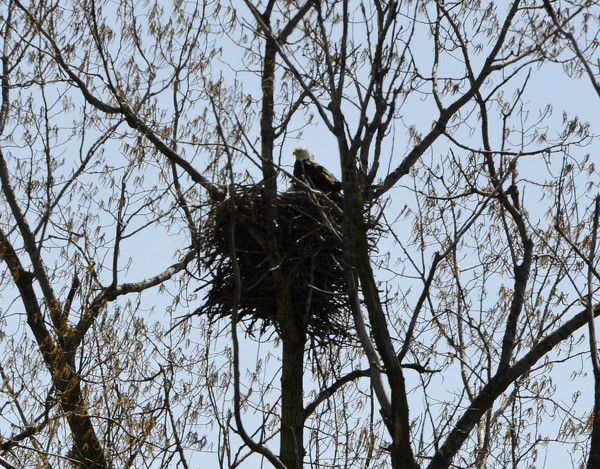Monday, April 27th, 2020
Eagle numbers are up
Magestic birds prove bald is beautiful in Ohio
By William Kincaid

Photo by Dan Melograna/The Daily Standard
An adult eagle perches on its nest near U.S. 127 south of Celina in the 1,408-acre Mercer County Wildlife Management Area.
COLUMBUS - The number of bald eagle nests in Ohio has skyrocketed 151% over the last eight years, according to the Ohio Department of Natural Resources.
It's safe to say Ohio, with its ample lakes, reservoirs, marshes and wetlands, is home to a thriving population of bald eagles, Division of Wildlife spokesperson Brian Plasters said.
Of the 707 nests confirmed over February and March, 16 are in Mercer County, compared with three in 2012, and four in Auglaize County, which had no nests in 2012, ODNR reported. Ottawa County on Lake Erie, is Ohio's bald eagle epicenter with 90 nests.
"We're seeing that Ohio is definitely attractive to eagles," Plasters said. "We have a lot of the spaces, the reservoirs and the rivers, obviously Lake Erie and other large reservoirs, too. They are definitely finding Ohio to be a nice place to build a nest and to raise young."
Calling the bald eagle "one of Ohio's greatest wildlife success stories," ODNR launched a bald eagle census in February and March with the help of citizen scientists. The last census had been in 2012.
"It's been eight years - that's a long time in the wildlife world - and we wanted to see what had happened," Plasters said. "We've seen a lot of of eagles. Everybody's seen a lot of eagles, and we wanted to see if we could get a more official account."
Volunteers submitted 2,500 reports of spotted nests to ODNR, Plasters said.
"Our staff (then) actually went around, whether it was a wildlife biologist, wildlife officer, (and) they confirmed it," Plasters explained.
ODNR is pleased with the soaring number of confirmed bald eagle nests in Ohio.
"We're definitely excited, and we're definitely happy to see so many," he said. "It's obviously a cool bird, and it gets a lot of attention and people like to see them, and it's our national bird."
Plasters credits the increase in nests to two key factors - the removal of the synthetic insecticide DDT from waterways and the opening of new bald eagle habitats.
Habitat destruction and degradation, illegal shooting and contaminated food sources, largely as a consequence of DDT, decimated the eagle population by the 1970s, according to the U.S. Fish and Wildlife Service.
Eagle eggs were affected by increased pesticide use during the 1950s and 1960s, according to Ohio History Central. The eggs did not hatch because they were either infertilized or their shells were so thin the weight of the adult would crush them. No young birds were surviving to replace the dying adults.
Eagles are not prolific nesters, Plasters said. Rather, they nest once a year and have up to three eaglets.
"It just took awhile for that (population) to build up," Plasters said about the rebound of bald eagles after DDT was discontinued.
Second, bald eagles are going to spaces where wildlife officials might not have thought they would venture.
Officials knew the bald eagles loved the big, open waters of Lake Erie, for example.
"But we're also seeing them on rivers. We're seeing them in wetland habitats," he noted, saying they're also frequenting large and small reservoirs. "We're seeing that as long as there's a good food source and there's a good habitat, then they're going to be in those spots."
Plasters said open water, marshes, wetlands and ample food sources of fish, ducks and other waterfowl create ideal conditions for bald eagles.
He pointed to the newly created wetlands in Mercer County as a potential reason for the increased number of bald eagle nests in Mercer County.
Mercer Wildlife Area Manager Sean Finke agreed that the area has indeed become attractive to bald eagles.
"They just thrive," he told the newspaper. "The habitat's there, and the food's available."
Asked the location of the bald eagle nests in Mercer County, Finke pointed to two in 1,408-acre Mercer County Wildlife Management Area in Montezuma, one near Celina Lynx Golf Club, two by Behm's Landing, one near Aqua View Estates near Prairie Creek, three by the Wabash River and one south of Menchhofer Woods.
"Most of the eagles have all hatched," Finke said. "They're small right now, so the male and female are feeding them. So you'll see them come and go to the nest now."
The best place to see a bald eagle is the Prairie Creek Treatment Train, Finke said.
"The walking path around Prairie Creek Treatment Train, you can see (the nest) there. Actually, you're looking dead at it right from the parking area at Prairie Creek," he said.
Many people from outside the area come here hoping to spot a bald eagle and other birds, he said.
"Especially now that we got the pelicans out there," he added.
According to ODNR, bald eagles in Ohio typically lay eggs and incubate in February and March. Young eagles leave the nest about three months later, usually in June.
However, ODNR stresses that bald eagles are protected under state and federal laws, adding it's illegal to disturb bald eagles. Bald eagle spotters are advised to respect the birds' space and stay at least 100 yards away from the bird or nest.
"What I've been telling people is if you can get out early in the morning, they're going to be active right away," Plasters noted. "It's going to wake up whatever time the sun starts coming up. It's going to get hungry, and it's going to start searching for food."
The bald eagle was once an endangered species, with only four nesting pairs in Ohio in 1979, ODNR states. However, thanks to partnerships between the Division of Wildlife, Ohio zoos, wildlife rehabilitation facilities, concerned landowners and sportsmen and women the population grew.
The bald eagle was removed from the federal list of threatened and endangered species in 2007 and from Ohio's list in 2012, according to the ODNR release.

Photo by Dan Melograna/The Daily Standard
It's easy to spot bird nests at Mercer County Wildlife Management Area before trees start to bud.


